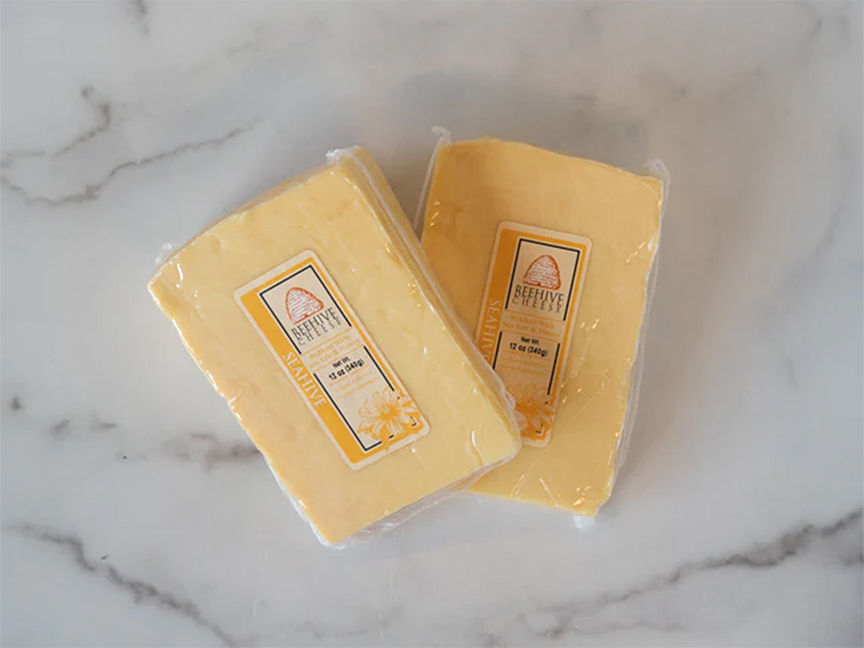
Wine and Cheese Pairing next Wednesday!
Beehive “Seahive” Cheddar is just one of the artisanal cheeses we are featuring this month at Boulder Wine Merchant. Click here to view all our featured cheeses. And please visit us next Wednesday for a wine and cheese tasting. Details below.
Cheese and Wine Pairing
Some things in the culinary world were just meant to be together, and the most rewarding and complex pairing of them all is wine and cheese. It is possible to create a marriage of flavors and textures that elevate your enjoyment of the components. Here are a few basic principles that can help you navigate the vast sea of wine and cheese pairings.
Regional
“What Grows Together, Goes Together” serves as a guiding rule when it comes to wine and cheese pairings. Selecting a wine and cheese from the same traditional, European region is a surefire bet. Their local food and wine have evolved together over hundreds of years; they already have it figured out for you.
Examples:
Loire Sauvignon Blanc with Goat Cheese
Piedmont Nebbiolo with Tallegio
Rioja with Manchego
Bordeaux with Cheddar
Weight & Intensity
In order to maintain balance, you must take the intensity of the flavor profile and body weight of both the wine and cheese into consideration. You do not want one to overpower the other. You can also base your selections off of the acidity. For instance, when you pair a high acid wine with a high acid cheese, they cancel out the acidity and allow the less dominant flavors to shine. You don’t want to pair your California Cabernet Sauvignon with a young, delicate Brie. Similarly, a big Stilton Blue cheese will overwhelm your palate and ruin a perfectly quaffable Sancerre.
Examples:
Sauvignon Blanc with Chevre
Zinfandel or Port with Blue cheese
Pinot Noir with Brie
Merlot with Monterrey Jack
Aged Cheeses
Some cheeses are meant to be enjoyed young, but others benefit from the process of ageing, called “affinage”. As cheeses age, they lose moisture. When this happens, they become richer, fattier, and show more distinct flavors. Crystals of calcium lactate and tyrosine may form. The key is to pair bolder style wines with aged cheeses. The fats in the cheese cut through the tannins in fuller bodied red wines and give the other flavors an opportunity to shine through.
Examples:
Oaked Chardonnay with aged Gouda Orange wine with extra aged Gouda
Australian Shiraz with aged Cheddar
Contrasting Styles
You can use the acidity of a wine to cut through fat. Cheese eaten on its own can be soft or hard, sticky or granulated on the palate. The acid or tannin in a wine can help make a cheese more palatable to enjoy. Just as tannins cut through fatty cheeses, acid helps cut through the stickier ones. A light sparkling wine can be used as a palate cleanser, making those triple creams a bit easier to swallow. And since both have delicate flavors, one will not overpower your perception of the other.
Another classic rule is that opposites attract. Sweet and salty foods complement one another splendidly. This also works with sweeter style wines and pungent, stinky cheeses.
Examples:
Port with Blue cheese
Sauternes with Époisses
Prosecco with Parmesan
Gewurztraminer with Morbier
******
Wine Wednesday
Please join us on Wednesday, 2/21, 5-7pm, for our weekly complimentary tasting. This week we’ll be serving samples of some of our featured cheeses accompanied by our favorite wine pairings.
Cheese and Wine Pairings:
Claude Manciat Crémant de Bourgogne Brut NV ($17.99) – with Delices de Bourgogne
Gulp “Hablo” Orange 2022, Jumilla 1L ($24.98) – with Ewephoria
Chateau de Montfaucon “Baron Louis” Lirac 2018 ($29.98) – with Cave-aged Gruyere
Dehesa la Granja Tempranillo 2018, Castilla y Leon ($23.98) – with Idiazabal